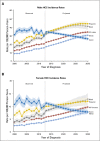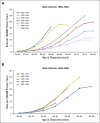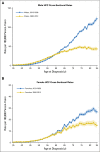Future of Hepatocellular Carcinoma Incidence in the United States Forecast Through 2030
- PMID: 27044939
- PMCID: PMC4966339
- DOI: 10.1200/JCO.2015.64.7412
Future of Hepatocellular Carcinoma Incidence in the United States Forecast Through 2030
Abstract
Purpose: Hepatocellular carcinoma (HCC) incidence rates have been increasing in the United States for the past 35 years. Because HCC has a poor prognosis, quantitative forecasts could help to inform prevention and treatment strategies to reduce the incidence and burden of HCC.
Methods: Single-year HCC incident case and population data for the years 2000 to 2012 and ages 35 to 84 years were obtained from the SEER 18 Registry Database. We forecast incident HCC cases through 2030, using novel age-period-cohort models and stratifying by sex, race/ethnicity, and age. Rates are presented because absolute numbers may be influenced by population increases.
Results: Rates of HCC increased with each successive birth cohort through 1959. However, rates began to decrease with the 1960 to 1969 birth cohorts. Asians/Pacific Islanders (APIs) have had the highest HCC rates in the United States for many years, but the rates have stabilized and begun to decline in recent years. Between 2013 and 2030, rates among APIs are forecast to decline further, with estimated annual percentage changes of -1.59% among men and -2.20% among women. Thus, by 2030, Asians are forecast to have the lowest incidence rates among men, and Hispanics are forecast to have the highest rates among men (age-standardized rate, 44.2). Blacks are forecast to have the highest rate among women (age-standardized rate, 12.82).
Conclusion: Although liver cancer has long had some of the most rapidly increasing incidence rates, the decreasing rates seen among APIs, individuals younger than 65 years, and cohorts born after 1960 suggest that there will be declines in incidence of HCC in future years. Prevention efforts should be focused on individuals in the 1950 to 1959 birth cohorts, Hispanics, and blacks.
Published by the American Society of Clinical Oncology.
Conflict of interest statement
Authors’ disclosures of potential conflicts of interest are found in the article online at
Figures




References
-
- Smith BD, Morgan RL, Beckett GA, et al: Recommendations for the identification of chronic hepatitis C virus infection among persons born during 1945–1965. MMWR Recomm Rep 61:1-32, 2012. - PubMed
-
- King DE, Matheson E, Chirina S, et al. The status of baby boomers’ health in the United States: The healthiest generation? JAMA Intern Med. 2013;173:385–386. - PubMed
MeSH terms
LinkOut - more resources
Full Text Sources
Other Literature Sources
Medical
Miscellaneous

